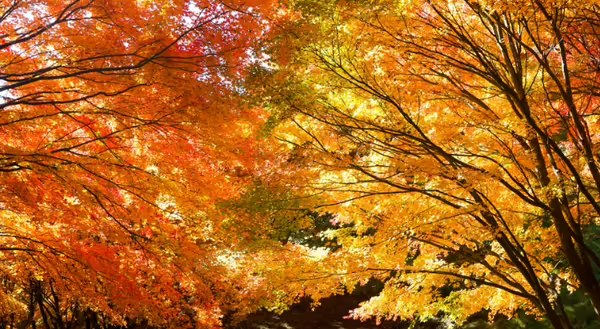
With over 250 species of trees growing across Illinois, there is a guaranteed assortment of tree shapes, sizes, and forms throughout the landscape. This botanical diversity becomes especially striking in autumn, when the foliage bursts into a spectacular array of colors and hues.
Fall brings a season of change and a breathtaking transformation. Deciduous trees, those that lose their leaves every fall, create a stunning fall display as they prepare for the winter season. With hues of red, yellow, orange, bronze, brown, and purple, the scenery becomes a vibrant and beautiful work of art.
Ever Wonder How This Happens?
With daylight hours decreasing and the sun lower in the sky, the production of chlorophyll—the green pigment responsible for energy production in leaves—slows down. As the green fades, other pigments that have been present in the leaves all along, hidden beneath the chlorophyll, begin to show. With food production winding down, it’s their moment to shine, revealing the brilliant reds, oranges, and yellows of autumn.
Why Do Some Leaves Turn Brilliant Shades of Yellow, Red, and Orange, and Others Simply Turn Brown?
The answer lies in the pigments within the leaves. Anthocyanins produce reds and purples, carotenoids create oranges, and xanthophylls yield yellows. Different tree species contain varying levels of these pigments. When chlorophyll—the green pigment—breaks down in the fall, these hidden colors emerge. If a leaf lacks these pigments, it will turn brown as the chlorophyll fades.
Why Do Some Leaves Turn Brilliant Shades of Yellow, Red, and Orange, and Others Simply Turn Brown?
The intensity of autumn foliage varies annually and is influenced by seasonal weather patterns and the natural differences among tree and shrub species. Vibrant colors are enhanced by a combination of sunny fall days, cool nights, and sufficient rainfall. All these conditions help bring out the pigments responsible for reds, oranges, and yellows.
If you're hoping to add a splash of autumn color to your yard, consider planting one of these standout species: black gum, bald cypress, ginkgo, sweet gum, sassafras, oaks, or maples. Plant a variety of tree species in your yard rather than just one type to create a bright and colorful autumn display.
Large shade and ornamental trees are not the only ones on display this season; many shrubs rival the large trees with their fall color. Oakleaf hydrangea, chokeberry, Virginia sweetspire, viburnums, native sumacs, and red twig dogwood are all wonderful selections for Illinois landscapes.
As the days remain cool and plants prepare for winter dormancy, take a drive under the canopy of color—too soon it will be swept away with the arrival of winter’s chill.